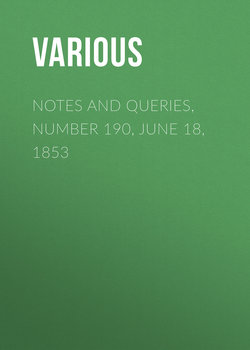Читать книгу Notes and Queries, Number 190, June 18, 1853 - Various - Страница 8
Queries
ОглавлениеHOUSE-MARKS
Are there traces in England of what the people of Germany, on the shores of the Baltic, call Hausmärke, and what in Denmark and Norway is called bolmærke, bomærke? These are certain figures, generally composed of straight lines, and imitating the shape of the cross or the runes, especially the so-called compound runes. They are meant to mark all sorts of property and chattels, dead and alive, movable and immovable, and are drawn out, or burnt into, quite inartistically, without any attempt of colouring or sculpturing. So, for instance, every freeholder in Praust, a German village near Dantzic, has his own mark on all his property, by which he recognises it. They are met with on buildings, generally over the door, or on the gable-end, more frequently on tombstones, or on epitaphs in churches, on pews and old screens, and implements, cattle, and on all sorts of documents, where the common people now use three crosses.
The custom is first mentioned in the old Swedish law of the thirteenth century (Uplandslagh, Corp. Jur. Sveo-Goth., iii. p. 254.), and occurs almost at the same period in the seals of the citizens of the Hanse-town Lubeck. It has been in common use in Norway, Iceland, Denmark, Sleswick, Holstein, Hamburgh, Lubeck, Mecklenburgh, and Pomerania, but is at present rapidly disappearing. Yet, in Holstein they still mark the cattle grazing on the common with the signs of their respective proprietors; they do the same with the haystacks in Mecklenburgh, and the fishing-tackle on the small islands of the Baltic. In the city of Dantzic these marks still occur in the prayer-books which are left in the churches.
There are scarcely any traces of this custom in the south of Germany, except that the various towers of the city-wall of Nurnberg are said to bear their separate marks; and that an apothecary of Strasburg, Merkwiller, signs a document, dated 1521, with his name, his coat of arms, and a simple mark.
Professor Homeyer has lately read, before the Royal Academy of Berlin, a very learned paper on the subject, and has explained this ancient custom as significant of popular law, possibly intimating the close connexion between the property and its owner. I am sorry not to be able to copy out the Professor's collection of runic marks; but I trust that the preceding lines will be sufficient in order to elicit the various traces of a similar custom still prevalent, or remembered, in the British isles; an account of which will be thankfully received at Berlin, where they have lately been informed, that even the eyder-geese on the Shetlands are distinguished by the marks of their owners.
α.
